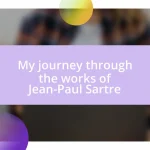Key takeaways:
- Bob Dylan’s lyrics reveal deep human emotions and personal reflections, encouraging listeners to confront their own truths.
- His storytelling techniques, such as vivid imagery and nonlinear narratives, create immersive experiences and challenge traditional storytelling forms.
- Symbolism in Dylan’s work conveys layers of meaning, prompting introspection about life’s journeys and transitions.
- Personal connections to Dylan’s themes of nostalgia and reflection highlight the universal nature of his lyrical brilliance.

Discovering the depth of lyrics
When I first stumbled upon Bob Dylan’s lyrics, it felt like peeling back the layers of an onion—each verse revealing something deeper. I remember listening to “Tangled Up in Blue” on a rainy afternoon, and I was struck by how his storytelling wove through time and perspective, making me reflect on my own experiences. Have you ever felt that perfect alignment between a song and your life?
As I revisited his lyrics, I couldn’t help but notice how they mirrored the complexities of human emotion. In “Like a Rolling Stone,” the raw honesty about vulnerability resonated with me in a way few other artists achieved. It’s as if Dylan stripped away the façade we often wear in our daily lives, inviting listeners to confront their truths.
One line can evoke a powerful feeling; just think about how easily it can stick with you. “The answer, my friend, is blowin’ in the wind” was a revelation that made me ponder the elusive nature of truth. I found myself asking, are we all just chasing those answers without realizing they might be right in front of us?

Analyzing storytelling techniques in songs
Dylan’s craftsmanship lies in his ability to create vivid imagery that pulls listeners into the stories he tells. Take “The Ballad of Hollis Brown,” for instance; his use of stark, haunting images portrays despair in a way that feels immediate and real. When I first listened, I felt as if I were standing in the dusty plains, experiencing the weight of poverty alongside the protagonist. This immersive quality makes his narratives gripping and unforgettable.
What often strikes me about Dylan’s storytelling is his masterful use of character development. In “Lily, Rosemary and the Jack of Hearts,” I remember being captivated by how each character unfolds through action and dialogue. It’s like watching a mini-drama play out, making you root for some while questioning the motives of others. The complexity of relationships mirrors the intricacies of real life, forcing me to think about the stories behind the faces we encounter daily.
Finally, Dylan challenges traditional narrative structures, employing nonlinear timelines to deepen his storytelling. Songs like “Subterranean Homesick Blues” feel almost cinematic in that they throw you into a world without explanation. I was both bewildered and enthralled, trying to piece together the jigsaw of thoughts he presented. Has there ever been a song that made you rethink the way stories could be told? I believe Dylan’s work redefines storytelling in music, compelling us to engage with the form in fresh ways.
| Storytelling Technique | Example Song |
|---|---|
| Imagery | The Ballad of Hollis Brown |
| Character Development | Lily, Rosemary and the Jack of Hearts |
| Nonlinear Narrative | Subterranean Homesick Blues |

Understanding symbolism in Dylan’s work
Dylan’s work is like a treasure chest of symbolism, revealing layers of meaning that resonate with me on various levels. I recall my first listen to “Desolation Row,” where his vivid references created an almost surreal landscape filled with characters and ideas that lingered in my mind. Each symbol—be it the imagery of the “moon” or the “jester”—hit me in unexpected ways, sparking a curiosity about what they represented, both to him and to my own life.
Here are some key symbols often found in Bob Dylan’s lyrics:
- The Jester: Represents the absurdity of life and the folly of humanity.
- The Road: Symbolizes the journey and the choices we make along the way.
- The Moon: Often associated with mystery, it embodies the search for truth amid chaos.
- Desolation: Reflects feelings of alienation and the struggles of existence.
Each time I explore Dylan’s lyrics, I find something new. It’s not just about the words; it’s about how they speak to our shared human experiences, drawing us into a conversation that’s uniquely our own. I remember feeling an overwhelming sense of nostalgia listening to “Knockin’ on Heaven’s Door,” where the symbolism of doors represents opportunity and transition. Each line felt like an invitation to contemplate my own transitions in life. Dylan’s use of metaphor transforms ordinary experiences into profound reflections that resonate deeply with many.

Personal reflections on lyrical impact
There’s something about Dylan’s lyrics that really taps into the core of human emotion. When I first heard “Tangled Up in Blue,” I was astonished by how he wove together memories and perspectives. Each verse felt like a conversation with my own past, reflecting moments of love and loss. It made me realize how interconnected our experiences can be, and I had to ask myself: have I ever listened to a song that forced me to revisit my own memories?
Listening to songs like “Forever Young,” I often feel a wave of nostalgia wash over me. The simple yet profound message of hope resonates deeply within me, alternating between excitement and melancholy. It’s almost like Dylan was speaking directly to my younger self, reminding me of the dreams I held. This blend of personal recollections and universal themes is a hallmark of his lyrical brilliance, making me wonder—how can a few lines bring forth such a flood of feelings?
Moreover, Dylan’s ability to elevate seemingly mundane moments into poignant reflections is something I cherish. Take “Simple Twist of Fate,” for instance. I recall driving down a quiet road, the song enveloping me like a comforting blanket. The storytelling, with its ebb and flow, led me to think about serendipity and the unpredictable nature of life. What is it about certain lyrics that can evoke such a strong emotional response? It’s as if Dylan offers a mirror reflecting our own stories back at us, allowing us to draw parallels and find meaning in the chaos.














